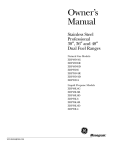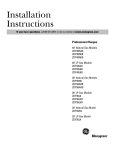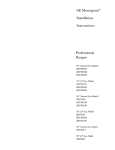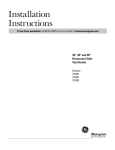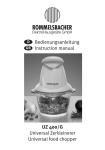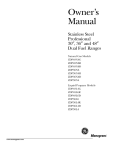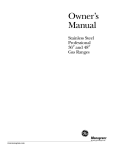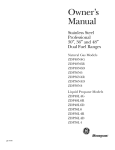Download Monogram ZDP30N4 Owner`s manual
Transcript
GE Monogram® Installation Instructions Professional Ranges 48" Natural Gas Models ZDP48N4G ZDP48N6R ZDP48N6D 48" LP Gas Models ZDP48L4G ZDP48L6R ZDP48L6D 36" Natural Gas Models ZDP36N6 ZDP36N4R ZDP36N4D 36" LP Gas Models ZDP36L6 ZDP36L4R ZDP36L4D 30" Natural Gas Model ZDP30N4 30" LP Gas Model ZDP30L4 Before you begin—Read these instructions completely and carefully. IMPORTANT: Save these instructions for local inspector’s use. IMPORTANT: OBSERVE ALL GOVERNING CODES AND ORDINANCES. NOTE TO INSTALLER: Be sure to leave these instructions with the Consumer. NOTE TO CONSUMER: Keep these instructions with your Owner’s Manual for future reference. CAUTION WARNING This appliance must be properly grounded. See “Electric Supply”, page 7. For Monogram local service in your area, 1-800-444-1845. For Monogram Service in Canada, Call 1-888-880-3030. For Monogram Parts and Accessories, call 1-800-626-2002. If you received a damaged range, you should contact your dealer. Installation of this range requires basic electrical, carpentry and mechanical skills. Proper installation is the responsibility of the installer. Product failure due to improper installation is not covered under the GE Appliance Warranty. See the Owner’s Manual for details. In the Commonwealth of Massachusetts: • This product must be installed by a licensed plumber or gas fitter. • When using ball type gas shut off valves, they shall be T-handle type. • A flexible gas connector, when used, must not exceed 3 feet. CAUTION: THESE RANGES SHOULD BE INSTALLED IN CONJUNCTION WITH A SUITABLE OVERHEAD VENT HOOD. Due to the high heat capacity of this unit, particular attention should be paid to the hood and duct work installation to assure it meets local building codes. Standard countertop and island installations: A 1200 CFM hood is recommended for 48" ranges. A 600 CFM hood is recommended for 30" and 36" Ranges. Hoods should be 24" min. deep and the same width as the cooktop. grounding must comply with applicable codes. In the absence of local codes, the gas range should be installed in accordance with the National Fuel Gas Code ANSI 223.1, latest edition and National Electrical Code ANSI/ NFPA 70, latest edition. CAUTION: These ranges weigh up to 600 pounds. Some disassembly will reduce the weight considerably. Due to the weight and size of the range and to reduce the risk of personal injury or damage to the product, TWO PEOPLE ARE REQUIRED FOR PROPER INSTALLATION. Check local building codes for the proper method of gas range installation. Local codes vary. Installation, electrical connections and Contents Design Information Models Available ......................................................... 3 Accessory Requirements .......................................... 3 Models Dimensions and Clearances .................... 4,5 Advance Planning ....................................................... 6 Tools & Materials Required ....................................... 6 Installation Preparation Power Supply Locations ............................................ 7 2 Installation Step 1: Remove Packaging ........................................ 8 Step 2: Level the Range .............................................. 9 Step 3: Install Anti-Tip Device ................................... 9 Step 4: Connect Range to Gas ................................ 11 Step 5: Install the Range Backguard ..................... 11 Step 6: Connect Electrical ....................................... 12 Step 7: Slide Range Into Position ........................... 12 Step 8: Replace Oven Doors ................................... 12 Step 9: Assemble & Adjust Burners ...................... 13 Step 10: Adjustable Low Burner Settings ............. 13 Finalize Installation ................................................... 13 Design Information Professional Ranges Models Available These ranges are factory set for either natural gas or liquid propane gas. Order the model for your installation situation. 36" Natural Gas Models: ZDP36N6 6 gas burners 48" Natural Gas Models: ZDP48N4G 4 gas burners, grill and griddle ZDP36N4R 4 gas burners and grill ZDP48N6R 6 gas burners and grill ZDP48N6D 6 gas burners and griddle 48" Liquid Propane Gas Models: ZDP48L4G 4 gas burners, grill and griddle ZDP48L6R 6 gas burners and grill ZDP48L6D 6 gas burners and griddle Accessory Requirements All models require the installation of a backguard. A backguard should be ordered at the same time as the range. Both must be on site at the time of installation. Order one backguard for 48" Models: ZX1B48 1-1/2" high backguard (required for island installations or installations where back wall is non-combustible such as brick, ceramic tile, marble, etc.) ZX12B48 12" high backguard ZX22B48 22" high backguard with warming shelf (2 piece) Order one backguard for 36" Models: ZX1B36 1-1/2" high backguard (required for island installations or installations where back wall is non-combustible such as brick, ceramic tile, marble, etc.) ZDP36N4D 4 gas burners and griddle 36" Liquid Propane Gas Models: ZDP36L6 6 gas burners ZDP36L4R 4 gas burners and grill ZDP36L4D 4 gas burners and griddle 30" Natural Gas Model: ZDP30N4 30" Liquid Propane Gas Model: ZDP30L4 Order one backguard for 30" Models: ZX1B30 1-1/2" high backguard (required for island installations or installations where back wall is non-combustible such as brick, ceramic tile, marble, etc.) ZX12B30 9" high backguard ZX22B30 22" high backguard with warming shelf (2 piece) 22" High Backguard With Warming Shelf 12" High Backguard (9" High for 30" Models) ZX12B36 12" high backguard ZX22B36 1-1/2" Backguard for 22" high backguard with warming shelf Island Installations only (2 piece) Installation Note: For approved installations to non-combustible back wall materials, consult material representative to ensure that the material has appropriate resistance to staining and/or discoloration. 3 Design Information Professional Ranges Product Dimensions & Clearances 21-1/4" 12" 1-1/2" s ckguard ptional Ba O s ckguard ptional Ba O 21-1/4" 12" 1-1/2" 35-1/4"-36-3/4" 35-1/4"-36-3/4" 47-7/8" 28-1/4" 48" Wide Range Models 28-1/4" 35-7/8" 36" Wide Range Models 29-1/16" 3-1/4" 21-1/4" 12" 12" 36" Min. to Combustibles High Shelf Low Back 12" Min. to Combustibles Without Backguard or 0" to Non-Combustible Wall with 1-1/2" Backguard 36" Min. to Combustibles 1-1/2" Backguard 0" Clearance 0" Clearance All Models 26" 28-1/4" 31-1/2" 45-5/8" 48" and 36" Range Models 4 Design Information Professional Ranges Product Dimensions & Clearances 27-3/8" ards Backgu Optional 3-1/4" 21-1/4" 9" 1-1/2" 12" 36" Min. to Combustibles High Shelf 21-1/4" 9" Low Back 35-1/4"-36-3/4" 0" Clearance 26-3/4" 29-7/8" 26-3/4" 29-1/4" 43-7/8" 30" Wide Range Models Note: Refer to Vent Hood Installation Instructions for hood height above the range. 30" Wide Range Hood Or 36" Wide Range Hood Or 48" Wide Range Hood 30"/36" Wide Models 4" 48" Wide Models 8" 30"/36" Wide Models 12" 48" Wide Models 16" 18" Min. 30"/36" Wide Models 4" 48" Wide Models 8" 12" 13" Max. 12" Min. to Combustible Material Each Side 36" Min. to Combustible Material From Cooking Surface Cooking Surface 3-1/4" 3-1/2" Electrical Supply Gas Supply 35-3/8" Max. for Counter Level 36-3/4" Max. with Range Leveling Legs Fully Extended 5 Design Information Professional Ranges Advance Planning Refer to “Dimensions and Clearances” for appropriate placement and necessary clearances when planning the installation. • Cabinetry can not be installed directly above the range. • We recommend the installation of a vent hood above the surface. –The vent hood must be at least 24" deep. –The vent hood must be the same width as the range. –For 48" models, we recommend the vent hood blower be 1200 CFM. –For 30" and 36" models, we recommend the vent hood blower be 600 CFM. • Working areas adjacent to the range should have 18" minimum clearance between countertop and cabinet bottom. • Clearance between range and side wall or combustible material must be at least 12" on each side. • Allow 36" min. above the cooking surface to combustible materials. • For 48" models, we recommend the vent hood blower be 1200 CFM. • For 30" and 36" models, we recommend the vent hood be 600 CFM. • Installation must conform with local codes. In the absence of local codes, the range must comply with the National Fuel Gas Code, ANSI Z223.1, latest edition. A.G.A. approved. If the range is installed in an island: • Allow 12" min. clearance at the back to combustible materials. Tools & Materials Required: 6 • Saw • Measuring tape • Carpenter’s square • Pipe and fittings as required. • Manual gas line shut-off valve. • Gas pressure regulator (supplied) • Large flat-blade screwdriver • Pipe wrench • Drill and appropriate bits • Safety glasses • Gas-resistant pipe joint sealant • 5 foot, 5/8" AGA-certified flexible metal gas supply line. –If required by local codes, use solid pipe fittings. Note: Purchase new flexible line. DO NOT USE OLD, PREVIOUSLY USED FLEXIBLE LINE. Installation Preparation Professional Ranges Power Supply Locations Gas Supply: • The natural gas models are designed to operate at 6" to 14" water column pressure. • The liquid propane models are designed to operate at 11 to 14" water column pressure. A regulator is required at the L.P. source to provide a maximum of 14" water pressure to the range regulator. • These gas ranges are supplied with 1/2" NPT female gas connection located at the left rear corner. • A minimum 5/8" dia. metal flexible line is required. • For flexible connection, locate pipe stub on the back wall as illustrated. — Use 5-foot, 5/8" long flexible gas supply line. • For rigid connection, locate the pipe stub as illustrated. • Install a manual shut-off valve in the gas line, in an easily accessible location. Electric Supply: These ranges must be supplied with 208/240 volt, 60 Hz., and connected to an individual, properly grounded branch circuit protected by a circuit breaker or time delay fuse (50 amp for 48" ranges, 30 amp for 36" ranges and 25 amps for 30" ranges). The receptacle must be a NEMA 14-50R devise to accept the 4-prong plug supplied with the range. 4" For 30"/36" Models 8" For 48" Models 12" Flex Line Gas Supply to Range 12" For 30"/36" Models 16" For 48" Models Electrical Supply 2" Maximum Protrusion From Wall For Gas Supply 3-1/4" NEMA 14-50R Receptacle 3-1/2" If the electrical service provided does not meet the above specifications, it is recommended that a licensed electrician install an approved outlet. • Locate the electric supply as illustrated. WARNING CAUTION The range is equipped for use with an electrical supply which uses a separate grounding conductor (4 wire system). Green Red If this range must be connected to an electrical system which utilizes a single conductor for ground and neutral (3 wire system), the grounding jumper at the terminal block must be connected. The grounding jumper is located behind the front kick panel. White Black Connect Here Terminal Block To connect grounding jumper: • Disconnect restraining clip holding jumper. • Connect green jumper to open terminal on neutral (white) portion of the terminal block. 7 Installation Professional Ranges 1 Step Before moving the range indoors: • Remove outer carton and packing material from the shipping base. Door Hinge Roller Remove Packaging Lock (Closed) Un-Lock Kick Panel • Remove the kick panel by removing 2 screws at the top and pulling forward. Remove oven doors: • Open the door fully and hold down. • Close the brass hinge latches to locked position on each side. • Carefully, lift and pull the door away from the range and out of the frame. Range Must be Uniformly Supported on Braces Left Rear Shipping Screws 22" Leveling Legs The range is secured to the skid with 2 bolts in the front and 2 “L” brackets on the bottom flange of the range back. Remove bolts and “L” brackets. To simplify handling and to reduce the weight of the range: • Remove the grates and drawers below the knobs. • Remove grill and griddle covers. DO NOT ATTEMPT TO REMOVE A GRILL OR GRIDDLE ASSEMBLY. • Remove the broiler pans/literature package from inside oven(s). 8 Due to the weight of these ranges, use a dolly with soft wheels to move this range. • Lift the range onto the dolly and move indoors. Installation Professional Ranges 1 Step Remove Packaging (continued) 2 Step Level the Range 3 Step Install Anti-Tip Device 36" and 48" Wide Models: • Remove the panel from the rear of the shipping pack. Lay the panel on the floor directly in front of the installation location. The range should be placed on this panel to prevent damage to the floor. All Models: • Remove the two strips from the oven interior. Place the strips on the floor at the left and right sides of the installation location. These strips provide a surface for sliding the range into the final position and will prevent damage to the floor. The leveling legs must rest permanently on these runner strips. Note: Rear range leveling legs are not accessible after installation. • Check to be sure the adjoining cabinets/ countertops are level, front to back and left to right across the opening of the range. • Measure the distance from the floor to the top of the countertop in the left and right rear corners. WARNING CAUTION • All Ranges Can Tip • Injury Could Result • Install Anti-Tip Bracket Provided • See Instructions The anti-tip bracket is designed to be installed on top of the slide (runners) provided with the range. Any other type of construction may require special installation techniques to insure adequate fastening of the anti-tip bracket to the floor or wall. • The bracket must be properly installed to prevent tipping of the range. • Read the AHAM Anti-Tip Safety brochure packed with the product. Range Opening Runners To Support Leveling Legs Panel • Adjust the height of the range to countertop height or higher. IMPORTANT: The range should always be installed at countertop height or higher. DO NOT INSTALL THE RANGE LOWER THAN ADJACENT COUNTERTOP HEIGHT. All Ranges must have an anti-tip device correctly installed according to these instructions. • If the range is pulled out from the wall for any reason, make sure that the device is properly engaged when pushed back against the wall or installation position. • If the anti-tip device is not engaged, there is a possible risk that the range can tip over and cause injury if you or a child stand, sit or lean on an open door. [4] #10 x 2" wood screws Anti-Tip Bracket AHAM Anti-Tip Safety Brochure 9 Installation Professional Ranges 3 Small Hole For Wood (2) Wood Screws into Installations (2 Total) Back Wall (All Installations) (2) Large Holes For Concrete Installations Step Install Anti-Tip Device (continued) Back Wall Small Holes For Wood Installations (2 Total) Wood Slide Strip Of Side Right ange or R Wall Dimension A A= Models 1/2" ZDP48 5/8" ZDP36 1/4" ZDP30 Dimension A Wood Construction: • Place the bracket against the back wall, into the right rear corner of the installation location. • See Dimension A, position the bracket the correct distance from the right side. Mark the 2 small screw holes for fastening the bracket to the floor and remove the bracket. • Drill two, 1/8" diameter pilot holes. • Fasten the bracket securely to the floor and wall using all 4 screws provided. 10 Concrete or Cement Construction: Hardware Required (not supplied): [2] sleeve anchors, lag bolts and washers. • Place the bracket against the back wall, into the right rear corner of the installation location. • See Dimension A, position the bracket the correct distance from the right side. Mark the 2 large holes for fastening the bracket to the floor and remove the bracket. • Drill recommended size holes for the hardware. • Install the sleeve anchors into the holes and then install the lag bolts through the bracket. The bolts must be properly tightened as recommended for the hardware. • Fasten the bracket securely to the floor. • Drive wood screws into the back wall. Installation Professional Ranges 4 Step Connect Range to Gas A manual shut-off valve must be installed where it will be accessible. Assure that gas is turned off at the shut-off valve. • Remove all burner/hanger screws. • Lift and remove all open top burners/hangers to reveal the gas inlet location at the back of the range. • Pull the flexible metal gas line through the back of the range and into the cooking area until it meets the regular. • Connect flexible metal connector to incoming gas line pipe stub. • Turn on gas and check for leaks: –Use a liquid leak detector at all joints and connections in the system. Flex or Rigid Gas Line To Regulator Regulator 36" Models Flex or Rigid Gas Line To Regulator Regulator 48" Models 30" Wide Models: Rigid pipe is factory installed from the regulator to the bottom rear of the range. Flexible line may be used to connect to the pipe stub. Factory Installed Rigid Gas Line Regulator 30" Models 5 Step Install the Range Backguard A backguard is required for all installations. • Insert the backguard into the guide channels on the back of the range. • Secure the backguard to the range at the rear with the 4 sheetmetal screws provided. • Install 2 or 3 screws through the front of the range, depending on your model. 11 Installation Professional Ranges Step 6 Plug power cord into properly grounded receptacle. 7 • Carefully, slide the range into position. –Be careful not to entange power cord and gas flexible tubing. • Be sure the right rear leg is engaged in the slot of the installed anti-tip bracket. • Check for proper installation by grasping the range at the top front edge and carefully attempt to tilt the range forward. • Check to be sure the front of the range is level. Adjust front leveling legs accordingly. • Replace the front kick panel by reversing the proceedure described in Step 1. 8 To replace the oven doors: • Slide the hinges into the openings. The hinge should rest in the center of each hinge roller. • Open the door fully and unlock hinge latches. Connect Electrical Step Slide the Range Into Position Step Replace Oven Door(s) CAUTION: Take care when replacing the oven doors. If the hinge latch is not securely locked, the hinge may snap back and separate. If the hinge separates, you must apply pressure (possibly with your foot) to press it back together and then engage the brass hinge latch. 12 Door Hinge Roller Lock (Closed) Un-Lock Installation Professional Ranges 9 Step Assemble & Adjust Burners • Replace the burner bowls and burner caps. • Adjustments should not be required, unless vibration during transit or variations in local gas supply make minor adjustments necessary. CAUTION: Burner adjustments must be made by a qualified technician at the time of installation. Extreme care should be used if adjustments are made after installation. • Burner flames should be blue and stable with no yellow or yellow tips, excessive noise or lifting of the flame from the burner. If any of these conditions exist, check that the air shutter or burner ports are not blocked. If one of these conditions continues, adjust the air shutter as required. –If the flame is too yellow, there is insufficient air flow, adjust the shutter counterclockwise to increase air inlet. –If the flame is noisy or tends to lift away from the burner, there is too much air. Turn the shutter clockwise to reduce air. 10 Step Adjustable Low Setting Burner Main Burner Venturi (rear) Igniter Simmer Burner Venturi (rear) Burner Air Shutter Main Burner Venturi (front) Simmer Burner Venturi (front) The open top burners and grill valves have an adjustable low setting. Each valve is individually tested and adjusted before it is shipped. Minor adjustments may be required due to fluctuations in local gas pressure. Adjustments to increase or decrease gas flow may be necessary. • Turn knob counter-clockwise to the LITE position. • Once lit, turn the know back to the “LOW” position. • Remove the knob. • Insert a thin-blade flat screwdriver into the valve shaft. (3/32" blade with recommended.) • Grip the shaft with pliers and turn the Finalize Installation Igniter Place the burner grates into operating position. Press corner of the grate to the cooktop. The grates should be seated and should not rock. Models equipped with grill and griddle: • The grill and griddle are secured with screws at the front. They are designed to be stationary and should not to be removed. screwdriver counter-clockwise to lower the flame, or clockwise to increase the flame. CAUTION: Do not turn the flame so low that it goes out, causing the igniter to spark. • When the desired setting is made, replace the knob and turn burner off. • The griddle has two leveling screws beneath the rear flue cover which can be used to adjust to the desired slope. The center screw is for shipping purposes only and should be removed. 13 Notes Professional Ranges 14 Notes Professional Ranges 15 Note: While performing installations described in this book, safety glasses or goggles should be worn. For Monogram® local service in your area, call 1-800-444-1845. Note: Product improvement is a continuing endeavor at General Electric. Therefore, materials, appearance and specifications are subject to change without notice. Monogram. ® We bring good things to life. Pub. No. 49-8814-5 Dwg. No. 164D3333P058 (N.D. 728) 3/03 10658 Rev. 7 GE Consumer Products General Electric Company Louisville, KY 40225 © 2003 General Electric Company
















